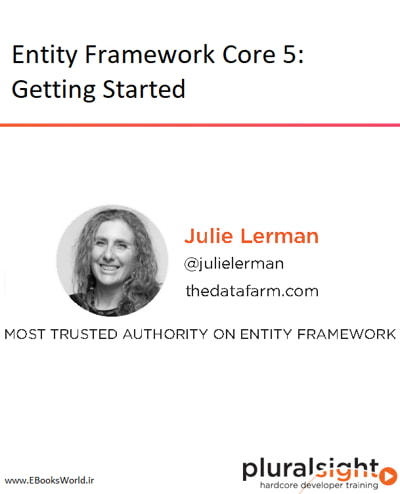در دوره Entity Framework Core 5: Getting Started (انتیتی فریمورک کور 5: شروع به کار)، موسسه Pluralsight که توسط Julie Lerman تدریس شده است، شما چگونگی کار با دادهها را در برنامههای دات نتی خود یاد میگیرید. ابتدا شما مزایای استفاده از EF Core 5 که ORM مایکروسافت است را بررسی میکنید تا شما را از کارهای متداول ذخیره و بازیابی دادهها در برنامه هایتان خلاص کند. در ادامه، نحوهی اطمینان از اینکه EF Core چگونه کلاسها و روابطشان در نرم افزار شما را به یک شمای پایگاه داده نگاشت میکند، خواهید آموخت.
در پایان، شما یاد خواهید گرفت که چگونه EF Core دادهها را در نرم افزار شما ذخیره و بازیابی میکند و از قابلیتهای بیشماری که به EF Core اجازه میدهد تا مدلهای پیچیده نرم افزار شما را درک کند، استفاده کنید. وقتی که این دوره را به پایان رساندید، شما مهارتها و دانش Entity Framework Core مورد نیاز برای ذخیرهی مستمر دادههای نرم افزارتان در data storeها را در اختیار خواهید داشت.
Table of Contents:
- Course Overview
- Course Overview
- Building Your First Application using EF Core
- Introduction and Overview
- Module Overview
- What Is Entity Framework Core?
- Getting the Correct Versions of .NET, SQL Server & Visual Studio for This Course
- Setting up the Solution
- Adding EF Core with the NuGet Package Manager
- Creating the Data Model with EF Core
- Specifying the Data Provider and Connection String
- A Sneak Peek at Writing and Reading Data
- Review and Resources
- Controlling Database Creation and Schema
- Introduction and Overview
- Understanding EF Core Migrations
- Adding Your First Migration
- Inspecting Your First Migration
- Using Migrations to Script or Directly Create the Database
- Reverse Engineering an Existing Database
- Review and Resources
- Defining Relationships in Your Model
- Introduction and Overview
- Learning More About One-to-Many Relationships
- EF Core’s Default Many-to-Many Mapping
- Storing Additional Data with Many-to-Many Payloads
- Configuring the Many-to-Many Payload
- Migrating the Many-to-Many Payload
- Adding a One-to-One Relationship
- Visualizing How EF Core Sees Your Model
- Review and Resources
- Interacting with Your EF Core Data Model
- Introduction and Overview
- Looking at SQL Built by EF Core
- Adding Logging to EF Core's Workload
- Benefiting from Bulk Operations Support
- Understanding the Query Workflow
- Filtering in Queries
- Aggregating in Queries
- Updating Simple Objects
- Deleting Simple Objects
- Understanding Disconnected Scenarios
- Persisting Data in Disconnected Scenarios
- Enhancing Performance in Disconnected Apps with No-Tracking Settings
- Review and Resources
- Interacting with Related Data
- Introduction and Overview
- Inserting Related Data
- Eager Loading Related Data
- Projecting Related Data in Queries
- Loading Related Data for Objects Already in Memory
- Using Related Data to Filter Objects
- Modifying Related Data
- Working with Many-to-Many Relationships
- Altering or Removing Many-to-Many Joins
- Adding a Many-to-Many Payload to Existing Join Table & Data
- Working with the Many-to-Many Payload Data
- Persisting Data in One-to-One Relationships
- Querying One-to-One Relationships
- Review and Resources
- Working with Views and Stored Procedures and Raw SQL
- Introduction and Overview
- Adding Views and Other Database Objects Using Migrations
- Using Keyless Entities to Map to Views
- Querying the Database Views
- Querying with Raw SQL
- Running Stored Procedure Queries with Raw SQL
- Executing Non-Query Raw SQL Commands
- Review and Resources
- Using EF Core with ASP.NET Core
- Introduction and Overview
- Adding the ASP.NET Core Project
- Adding a Samurai Controller to the Project
- Wiring up the ASP.NET Core App with the DbContext
- Running the Controller to See the Output
- Exploring and Debugging Insert, Update, & Delete Controller Methods
- EF Core 5 in Blazor Apps
- Review and Resources
- Automated Testing with EF Core
- Introduction and Overview
- A Very Quick Testing Overview
- Understanding What We Mean by “Testing EF Core”
- Creating Your First Test and Using It Against the Database
- Exploring Test Results & Performance Considerations
- Using the InMemory Provider in Place of a Database Provider
- Writing Your First Test with the InMemory Provider
- Refactoring and Testing Some Console App Logic
- Re-using an InMemory Provider Database
- Testing EF Core in an ASP.NET Core App
- Testing the API’s DbContext Configuration
- Review and Resources

 می پسندم
می پسندم
 به درد نمی خوره
به درد نمی خوره
















